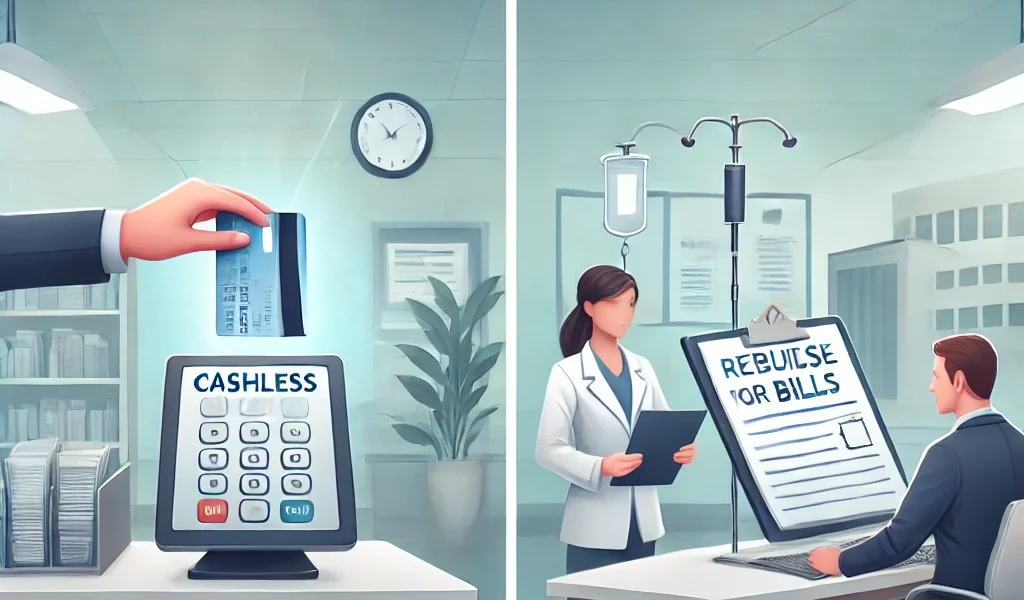Introduction
When you purchase an insurance policy, one of the critical factors to consider is how claims are settled. The two most common methods are cashless claims and reimbursement claims. Both have their own set of advantages and limitations, and understanding them can help you make informed decisions regarding your insurance coverage. In this guide, we’ll break down the differences, benefits, and potential drawbacks of each claim type and help you determine which one is better suited for your needs.
What Are Cashless and Reimbursement Claims?
Cashless Claims
A cashless claim means that the insured does not have to pay for the expenses upfront. Instead, the insurance company directly settles the bill with the network hospital or service provider.
How It Works:
- The insured individual visits a network hospital.
- Provides insurance details and gets approval for treatment.
- The hospital coordinates with the insurer for claim settlement.
- The insured only pays for expenses that are not covered under the policy.
Reimbursement Claims
A reimbursement claim requires the insured to pay for the expenses first and then claim a refund from the insurance company by submitting the necessary documents.
How It Works:
- The insured pays for the treatment at any hospital (network or non-network).
- The insured submits the bills, prescriptions, and other required documents to the insurer.
- The insurer verifies the claim and reimburses the amount as per policy terms.
Key Differences Between Cashless and Reimbursement Claims
| Feature | Cashless Claims | Reimbursement Claims |
|---|---|---|
| Payment Method | Insurer pays directly to the hospital | Insured pays first, then gets reimbursed |
| Hospital Type | Only network hospitals | Any hospital (network or non-network) |
| Paperwork | Minimal, as insurer coordinates directly | Extensive, requires submission of documents |
| Processing Time | Faster, since the insurer handles payment | Slower, due to document verification |
| Financial Burden | Low, as the insured does not need to pay upfront | High, since the insured has to pay first |
| Convenience | High | Moderate to low |
Pros and Cons of Cashless and Reimbursement Claims
Advantages of Cashless Claims:
- No need for upfront payments, reducing financial stress.
- Faster processing and approval.
- Minimal paperwork as hospitals coordinate directly with insurers.
- Ideal for emergency medical situations.
Disadvantages of Cashless Claims:
- Available only at network hospitals.
- Some expenses may not be covered under the policy.
- Requires prior authorization, which may cause delays in urgent cases.
Advantages of Reimbursement Claims:
- Can be availed at any hospital, providing more flexibility.
- No dependency on network hospitals.
- Useful in cases where cashless claim approval is delayed.
Disadvantages of Reimbursement Claims:
- The insured has to arrange funds for treatment upfront.
- Lengthy paperwork and documentation required.
- Processing time is longer as the insurer needs to verify documents.
Which One Should You Choose?
Choosing between cashless and reimbursement claims depends on various factors:
- If you prefer a hassle-free process with minimal paperwork, opt for cashless claims.
- If you want flexibility in choosing any hospital, then reimbursement claims work better.
- For planned treatments, cashless claims are ideal since you can check the hospital’s network status in advance.
- For emergency situations, cashless claims reduce financial strain and speed up the process.
- If the hospital is not in the insurer’s network, reimbursement is the only option.
Tips for Smooth Claim Processing
Regardless of the claim type, follow these best practices to avoid delays:
- Know Your Policy: Understand the coverage, exclusions, and claim process.
- Keep Documents Ready: Maintain medical records, prescriptions, and bills.
- Choose Network Hospitals for Cashless Claims: Always verify if the hospital is on the insurer’s network.
- Inform the Insurer Immediately: Report hospitalizations at the earliest for smoother processing.
- Follow Up: Keep track of the claim status and respond to queries promptly.
Conclusion
Both cashless and reimbursement claims have their advantages and limitations. If you value convenience and do not want to bear financial burdens upfront, cashless claims are the better choice. However, if you need more flexibility in hospital selection, reimbursement claims provide more options.
To make an informed decision, assess your financial situation, policy benefits, and hospital preferences before selecting an insurance plan. Having a clear understanding of both claim types ensures a smoother claim process and a stress-free experience in times of need.




